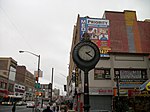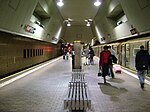2014 Queens hatchet attack
2014 crimes in New York (state)Anti-police violence in the United StatesAttacks in the United States in 2014Crimes in Queens, New YorkIslamic terrorism in New York (state) ... and 8 more
Jamaica, QueensNew York City Police DepartmentOctober 2014 events in the United StatesStabbing attacks in 2014Stabbing attacks in the United StatesTerrorist incidents in New York CityTerrorist incidents in the United States in 2014Terrorist incidents involving knife attacks
On October 23, 2014, a hatchet-wielding man, Zale H. Thompson, attacked four New York City Police Department (NYPD) officers on a crowded sidewalk in the Jamaica neighborhood of Queens, New York City. Officer Kenneth Healey was struck in the head, while Officer Joseph Meeker was injured in the arm. Also injured was a female civilian, who was struck by a stray bullet when two other officers shot and killed the perpetrator. Investigators discovered that Thompson was a recent Muslim convert. His attack was classified as an act of terrorism.
Excerpt from the Wikipedia article 2014 Queens hatchet attack (License: CC BY-SA 3.0, Authors).2014 Queens hatchet attack
160th Street, New York Queens
Geographical coordinates (GPS) Address Nearby Places Show on map
Geographical coordinates (GPS)
| Latitude | Longitude |
|---|---|
| N 40.70374 ° | E -73.799138 ° |
Address
160th Street 92-01
11433 New York, Queens
New York, United States
Open on Google Maps










